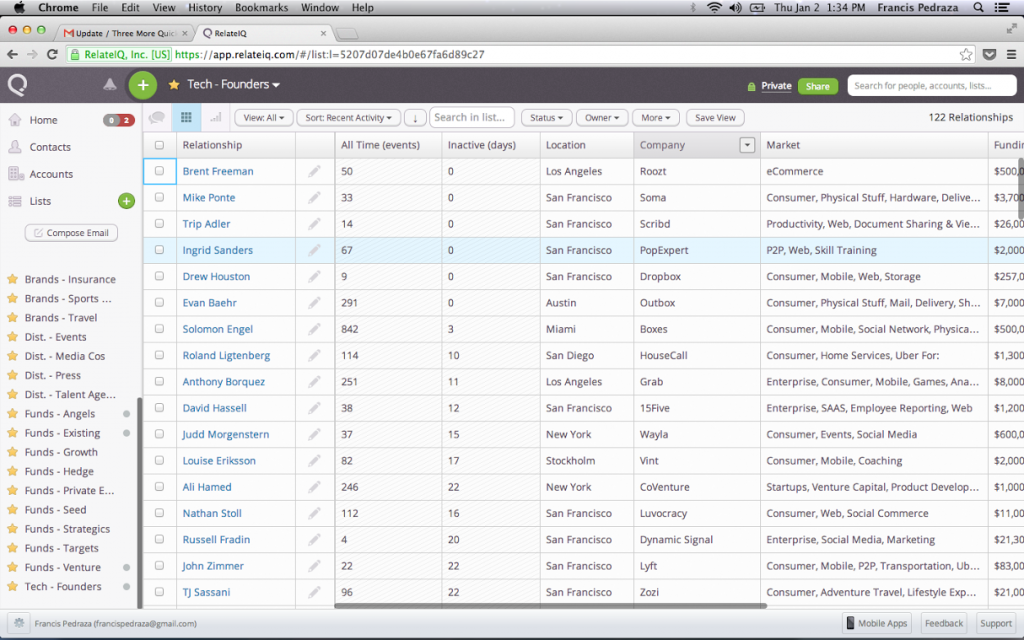The One Thing You Should Do After Meeting Anyone New

At 24-years-old, Francis Pedraza is the co-founder and CEO of a venture-backed company, Everest. In addition, he is an advisor to 10 tech companies, each of whom he does hundreds of introductions for in return for equity.
It is hard to predict how my Forbes interviews will go. Most top relationships builders are not able to articulate how they do what they do.
Francis does not fall into this camp.
Within a few minutes of talking with him, he had transformed my perspective on relationship building.
The elaborate system he has created allows him to dramatically scale the value he adds to the people in his network.
How could a 24-year-old founder who is busy building a company offer more introductions than venture capitalists whose full-time job is to find and support portfolio companies into which they’ve invested millions of dollars?
Why You Should Share Your Network With Other Entrepreneurs You’ve Vetted
Imagine building a road to an amazing place and then only using it once.
That would not only be a waste; it would be selfish.
You’ve already incurred the cost, and it doesn’t hurt you if other people use it. In fact, it helps to share because you build relationships with other drivers who appreciate your generosity.
Despite the obvious benefits, most entrepreneurs fail to proactively share their networks of vendors, investors, employees, and partners.
******************SPONSORED LINK********************
The Perfect Day Formula Helped Russell Brunson 10X His Money-Making Time
“The Perfect Day Formula is awesome. It showed me how to create my Perfect Day, and the very first day I used it was amazing. Now in my ‘2-hour mornings’ I get as much work done as I typically do in an 8-hour day. I’ve already moved things forward by the time my kids are awake, now the rest of the day is just a bonus. I hope that you try it You’ll get 10 times more stuff done.” – Russell Brunson, Serial Entrepreneur and Super Affiliate
Click here to get your Perfect Day Formula Kit today.
**************************************************************
They build it and then let it sit.
If you’re raising money, you talk to dozens of investors until you’re finished. Then, you focus on other networks. The same goes for interviewing dozens of employees and vendors to fill open positions. Once you fill a position, you stop looking until the next time you have a position.
Here’s the problem with the on/off approach: If you don’t always nurture these networks, then they are harder to activate when you need them.
Francis’ insight was to make introductions for other high potential tech companies to investors, designers, and engineers he already knew even when he didn’t immediately need these networks.
Speaking on why he made this decision, he shared two reasons:
- Building Relationships With Investors
- “When we raise our next round of financing, potential investors will be less likely to ignore me or act in bad faith, because they know that I’ve built a big network and proven its value.”
- Learning From Top Entrepreneurs In Other Sectors
- “By being a trusted advisor to other companies, I broaden my perspective in two ways. First, I become privy to the deepest challenges of other top tech companies. Secondly, I learn what they’re learning as they learn it.”
At this point, most people using Francis’ logic would take an ad hoc process to making introductions when people came top of mind.
Instead, Francis created an extremely powerful system that simplified and scaled his impact.
Focus On Quality Before Quantity
The difference between introducing an investor to a world-class entrepreneur and a talented entrepreneur is tremendous.
Investors earn almost their entire return from one in ten companies they invest in that hit it big.
With this in mind, Francis decided to actively search for and select high potential startups that he believed in that he could advise.
By primarily making only high-quality introductions to startups he had vetted, he could provide more value to investors and learn more from the entrepreneurs.
Why Making Hundreds of Introductions For A Single Company Makes Sense
Finally, instead of doing just a few introductions for each company, Francis does hundreds. To receive funding or to fill open positions requires talking to dozens of people. By only making a few introductions, you’re certainly helping, but you’re not pushing the ball forward as much as you could be given the need and your ability. Here’s Francis’ logic:
The reason I make hundreds of introductions rather than just a few is that fundraising is hugely impacted by momentum. It’s best to fundraise within a short window so that there is a lot interest at once and investors have time pressure. Furthermore, most investment meetings don’t turn into investments so startups need a lot of introductions in order to create momentum and find the needle in the haystack.
In order to scale the introductions you make, you have to organize your network in the right way. This brings us back to the title of the article…
Upfront Segmentation Is Better Than Top of Mind Later
The one thing you should you do after you meet someone is add them to the right cluster (i.e. – segment).
Most people treat their networks as one large connected cluster. The reality is that it is a set of many clusters.
This is critical because of relevancy. When you have a new article you want to share, a person you want to make an introduction for, or a dinner you want to invite people to, there two very likely possibilities:
- The opportunities are only relevant for a small segment (i.e., common passion, specific industry, location, etc.) of your network.
- Many of the opportunities you come across are relevant to the same few segments again and again.
The beauty of these two points is that if you find the segments that are relevant for your network, you can organize people into lists that you can reference whenever you need to.
Most people completely depend on who is top of mind. The problem is that the brain is designed to forget the large majority of what it’s exposed to. Just because someone doesn’t come to mind, it doesn’t mean that there aren’t many people who should have.
In my experience, by depending on what is top of mind, there is a good chance you’re missing relevant people by a factor of 10.
Because Francis divides his network into very clear segments upfront, knows how he is providing value, and has a tool that allows him to easily view segments, he is able to systematize all of his processes so they take dramatically less time.
Below is how Francis segments the investors in his network:
|
|
- Filtering.
|
|
To do segmentation, Francis uses social relationship intelligence platform, RelateIQ (see screenshot below). Started in 2013 with $40M+ in funding, the startup aims to use big data to help people build deeper relationships.
Collect Data On People To Segment, Not Just To Jog Your Memory
With this new approach, you collect basic data for one purpose; putting people in a segment. This stands into contrast with most systems that are purely designed to jog your memory for the future. Most segmenting / tagging systems get mired in complexity; tags that are too similar or no longer relevant. As a result, many give up because the process is too time-intensive. Patrick Ewers, one of silicon valley’s top relationship management coaches and an advisor to Contactually (a platform similar to RelateIQ), helps guide his clients on how to segment their networks. In his words, “Before you go out and tag every single person with every single interest, narrow it down. Otherwise, it becomes a real brute force effort. You constantly have to add and remove people and tags. It’s one of those things that gets stale really fast. It’s like your address book that you never use. The key idea is simplicity. I recommend starting with only 5 segments.” For too many people, networking is a bad word. It has come to signify individuals who use communication as an opportunity to broadcast what they want from others who aren’t even relevant to that product or service. Relationship building has become the antithesis of this idea. It represents personalized and relevant giving in order to build a relationship. Segmentation, when used properly, is one of the most powerful tools to deepen and scale the most important relationships in your life.
